Blog
Healthy, Simple, “Kiddo Approved” Summertime Treats (Ortho Friendly)
- Protein Pineapple Whip
- 2 Cups Frozen Pineapple
- 1 Frozen Small Banana
- 2 Oz Pineapple Juice
- 3 Oz Vanilla Greek Yogurt
- 1 ½ Scoops Vanilla Protein Powder
-Add everything to your Blender or Processor. Blend until Pineapple Whip is creamy.
-Enjoy scooped into a bowl with an Ice Cream Scooper or straight out of the Blender!!
Fun Toppings include Dark Chocolate Chips or Unsweetened Shredded Coconut
- Healthy Greek Frozen Yogurt
- 4 Cups Frozen Fruit
- 1/2 Cup Plain Greek Yogurt
- 2 Teaspoons Vanilla Extract
- 3 Tablespoons Honey
-Blend everything together for about 5 minutes until creamy.
-Enjoy immediately, or transfer to airtight container to freeze.
- Sugar Free Strawberry Fluff…Must set for 4 hours
- Sugar Free Strawberry Jello Mix
- Sugar Free Cool Whip
- 3/4 Cup Boiling Water and 1 Cup Ice Water
-Make sure Cool Whip is thawed.
-Prepare 1 Cup Ice Water and set aside.
-Whisk Jello Mix into boiling water until dissolved. It will slightly thicken.
-Whisk Ice Water into Jello mix until ice cubes melt.
-Whisk Cool Whip into Jello mixture until smooth. (2-3 minutes).
-Pour into individual containers or a casserole dish.
-Refrigerate 4 Hours or until firm.
- Chocolate Protein Pudding
- Greek Yogurt
- Protein Powder
- Cocoa Powder
- Maple Syrup or Honey for extra sweetness, if desired
–Place all ingredients into a blender and process until smooth.
If the mixture is too thick, you can add some milk.
-Enjoy alone or with some sugar free chocolate chips

What is plaque?

Do you ever notice your teeth feeling fuzzy like? We all have bacteria in our mouths that love to snack on food left behind on our teeth. Scientists call this biofilm because it is a colony of living microbes surrounded by a gluey polymer layer. This gluey coating allows the microbes to hang on to teeth so that they can grow into these colonies. This bacteria feeds on foods stuck on our teeth and then the bacteria releases acid. This acid that is released is what breaks down and destroys our teeth, causing decay and gum disease. Bacteria thrives on starches and sugar, making more acid attacks to your teeth.
The more plaque you have, the more acid is released and the more damage that is done. If plaque is not regularly removed it will build up and collect minerals from your saliva, causing it to harden into tarter. Plaque and tarter can get under the gum line and cause inflammation, which can become periodontal disease.
Getting regular exams and cleanings with your dentist is an important way to keep your teeth and gums healthy. Going to the dentist is more than just getting your teeth cleaned. Reviewing diet and care for oral health is an important part of every dental visit. Following your dentists instructions will provide you with a great smile for life.
Pacifier Use
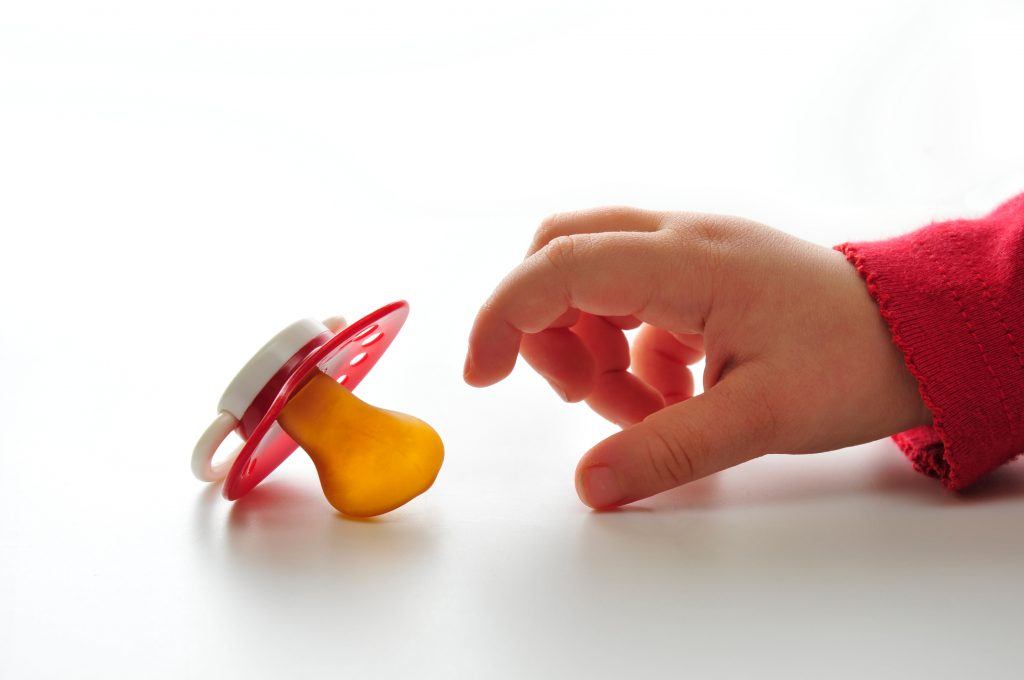
To comfort and pacify, pacifiers can be a sleep saver for some parents.
Pacifiers are the first self soothing tool a child can learn to use and can
help to provide a sense of calming.
Pacifiers have been studied to reduce sudden infant death syndrome
(SIDS), keeping infants from sleeping to deeply and stopping breathing.
Studies have shown that using a pacifier during the use of needles for
blood draws and immunizations, can help ease pain.
It is suggested that infants mostly use pacifiers to fall asleep. If your child
spits out their pacifier while sleeping, do not pop it back in for them
unless they wake up crying without it. Be sure to choose a pacifier with
a base that is at least an inch and a half across, to prevent any choking
hazards. Also, choose one that is one piece, two piece pacifiers run the
risk of separating. Check for tears or any sort of weak spots and throw
away if these are detected. Ventilation holes in the shield of the pacifier
are suggested in case it becomes lodged into the airway.
The American Academy of Pediatric Dentistry recommends that children
stop using pacifiers by the age of 3 years old. Your child may develop habit
forming use of a pacifier and this can lead to issues with space once teeth
start to erupt due to the suction effect on the soft upper palate of the mouth.
Try to phase out using the pacifier around the age of 6 months if possible,
since the cons start to out weigh the pros at this point. Many children do
stop using on their own between the ages of 2 to 4 years old. If you struggle
with getting your child to quit using a pacifier, consult your pediatric
Dentist for advice.
Tips to stop the use of a pacifier with a toddler
- Time it right. Do not start this process during a stressful time
- Wean gradually and create no paci times
- Offer an alternative comforting item such as a chosen stuffed animal or a special blanket
- Praise your child when they make the big kid decision to stop use
- Read your child books like bye bye binky
- Stick to your plan and stay consistent
White Crowns for Children
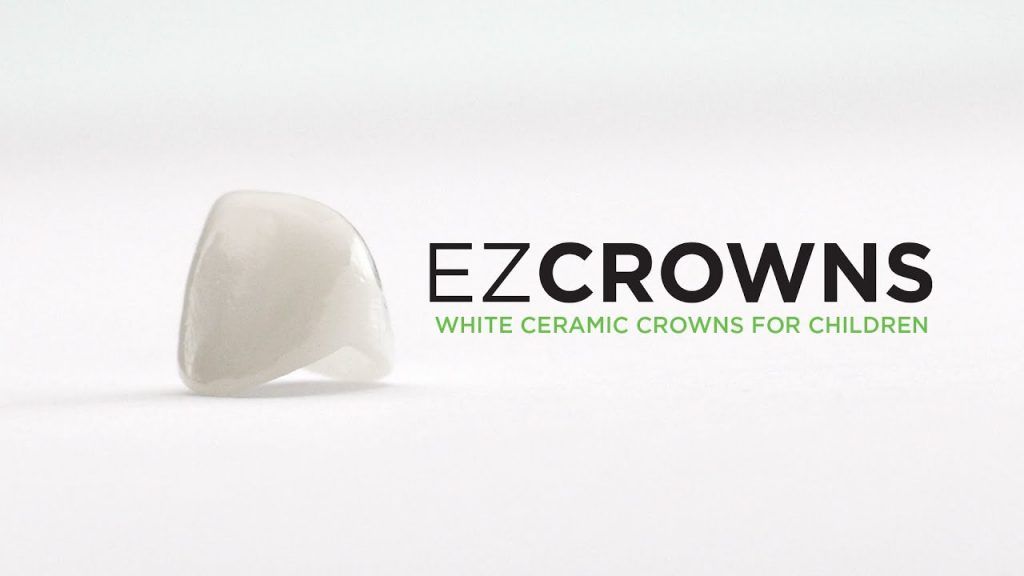
It is great now that children have the option of all white crowns. In the past, stainless steel crowns were used and sometimes a stainless steel crown with a white facing was used for front teeth.
Our office uses Sprig fully white prefabricated ceramic crowns especially designed for children. These crowns are made of solid zirconia , a biocompatible material. From every angle, these crowns are extremely esthetic.
If a child has a cavity that is still small, the dentist can do a filling. When front teeth especially, develop a lot of decay, it is nice to have the option of a fully white crown. This option frees children from feeling self conscious and even from being teased by other children as they grow and wait for their grown up teeth to come in. Your child’s smile will look healthy and natural, while raising self confidence. These crowns can be used in both the front and the back of your Childs mouth.
These white crowns are more difficult to place, require special skill and can take more time to do. If a child needs multiple white crowns and the child has extensive decay, sometimes it is recommended to do treatment under general anesthesia.
Metal free, highly durable and aesthetically superior, make Sprig white crowns a wonderful choice for children.
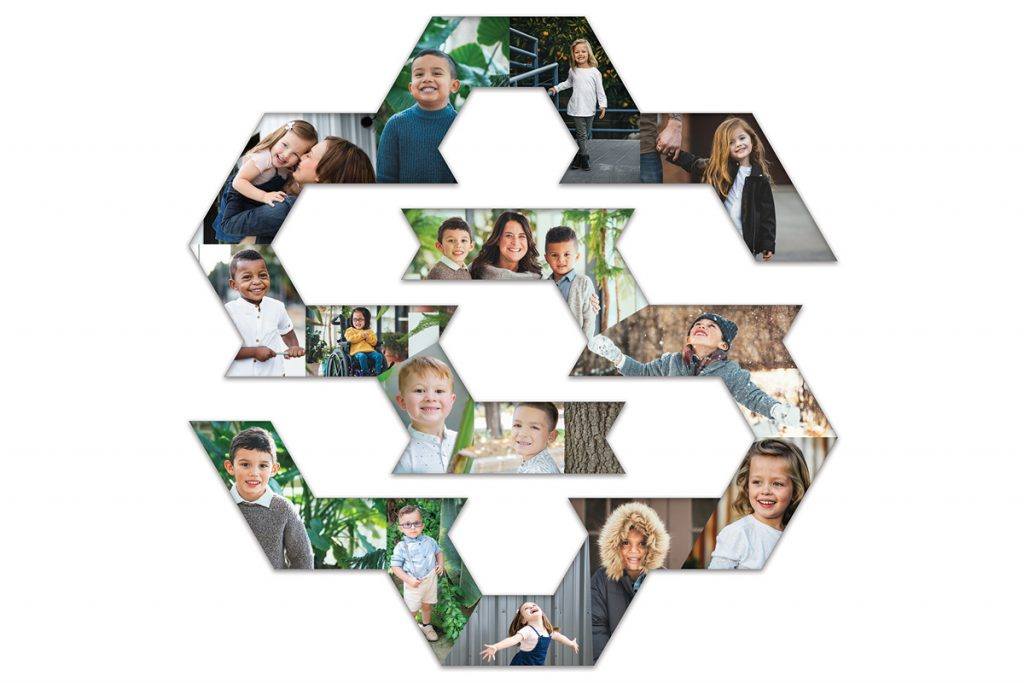
Eating with Braces
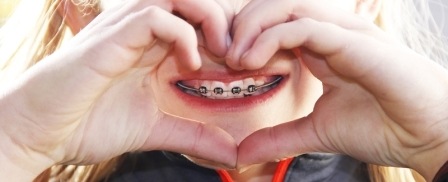
What you should and should not eat is an important topic when starting orthodontic treatment. Eating the wrong things can cause the different parts of your braces to break, slowing down treatment and causing parents more trips to the orthodontist office. What you eat while in braces also effects your oral health. Braces need extra care when cleaning and when food gets stuck in there, cavities can follow.
Sugar: To much sugar is never a good thing for your teeth or health. Limit sugary drinks and sticky sugary foods. Sugar can feed and create more plaque releasing acid, causing more destructive bacteria around orthodontic appliances. There are many more nooks and crannies for plaque to hide and build up, causing decay and weakened enamel in these areas.
Starch: Breads, crackers and anything flour can make a sticky paste in your mouth. Starch can really get into places and stick. After enjoying those pretzels and golf fish crackers, we highly suggest you brush and floss after.
Hard and crunchy: I love crunchy potato chips and admit that I would miss this the most while in braces. It is suggested to cut harder stuff into small pieces and to never bite down directly into crunchy or harder foods. Not only can you cut things up but you can substitute foods that you like for something less hard that you like. Thin lays potato chips are soft and instead of a hard candy, eat some milk chocolate.
Remember there are plenty of great foods you can eat, like cheese! Be mindful of what and how you eat it. Take extra good care of your teeth and braces with all the great cleaning tools that are available for people in orthodontic treatment.
Self Esteem and your smile

It takes twelve muscles to smile and 113 to frown. There are so many important moments in a persons life that begin with a smile. A beautiful and healthy smile can effect many aspects of ones appearance and personality.
If you have a great smile already, you might take it for granted. There are many people, including teens, that feel the need to hide their smile. When crooked teeth, staining or missing teeth are the case, self esteem can be greatly impacted by this. A wonderful smile is linked to good self esteem and good self esteem is linked to happiness.
Not just straight teeth, but healthy teeth also plays a role in how we feel about our smiles. People who avoid going to the dentist have higher rates of gum disease, missing teeth, staining and over all poor hygiene. You and your family need to make it a priority for regular dental check ups with cleaning. Physical health can be effected by gum disease along with feeling self conscious about the appearance of your smile.
How can you improve your smile and your families too?
- Go to the dentist twice a year for exam and cleaning
- Brush 2 to 3 times a day and of course floss. Having a flosser in a convenient place like your car or your favorite chair by the TV can increase the chance of you doing it.
- Get orthodontic treatment for crowding, spacing and/or bite issues. Make sure to wear your retainer at night for life!
- Whiten your teeth with the many products available.
- Cosmetic dentistry is a great option for some people that have certain concerns about their smile. Choose a dentist that is certified in this area.
Feel better about yourself and give your child the gift of a beautiful and healthy smile!
Why? How? When? to use a rapid palatal expander (RPE)
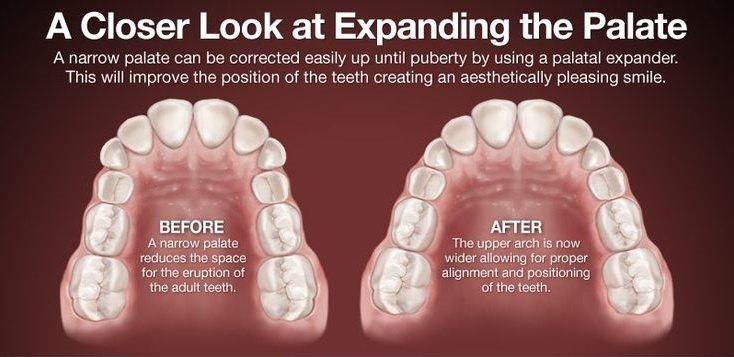
Why a palatal expander:
An RPE is a great appliance that can be used in youth to correct some common bite issues.
- Crowding – Not enough room for all of the permanent teeth to erupt in an ideal position. The upper jaw sometimes is very narrow, contributing to not enough space.
- Impacted teeth – When there is not enough space, permanent teeth can become trapped and will not erupt ( come in ) without orthodontic help. Widening the upper jaw can create more space, giving teeth some more room to move.
- Crossbites – Upper teeth should fit over the lower teeth, like a lid on a jar. A crossbite happens when one or more of the teeth in the upper jaw are on the inside or inward of the teeth in the lower jaw. Expansion of the upper jaw puts these teeth where they are suppose to be.
How does a palatal expander work?
Once bands are placed, a mold is taken and an the RPE appliance is made for the patient. Once glued into position, a key is given and instructions are given on how to turn and how many times to turn.
The upper jaw has a suture dividing it. Before puberty, it is possible to expand the upper jaw and push this suture apart. The RPE needs to stay in place for a good 4 to 6 months because new bone will grow into the space created. Each turn widens a very small distance, but over time, the palate becomes wider.
When is the best time to use a palatal expander?
The orthodontist likes to work with children’s natural growth. After an evaluation and a treatment plan are put together, the orthodontist will consider tooth and skeletal development along with growth spurts to determine the best treatment time for children. The majority of malocclusion’s ( bite problems ) are easiest to treat before a child hits puberty.
Sippy Cups and tooth decay

The connection to tooth decay and sippy cups is logical but yet it seems pacifiers and bottles get more of a bad wrap. Sippy cups were developed to transition from bottles to regular cups. When toddlers drink from these cups, they immerse the six front upper teeth in a drink that contains some sort of sugars. The convenience of these sippy cups leads children to sip on them throughout the day and all day long. This means sugars on the teeth for long periods of time which leads to the breakdown of enamel and cavities.
Even healthy juices and milks contain natural sugars that can decay these teeth. It is recommended that you give your child water throughout the day and only give other beverages at meal time. Like bottles, sippy cups should not be given when a child goes down for a nap or for the night. Sippy cups should be used as a transitional step for children, not as a long term solution for convenience.
This topic brings up a further point of getting young children to the dentist by 1 year of age. Pediatric dentists provide information on all topics for oral health care. Teaching parents important habits for their children and going over growth and development, an extremely important part of long term oral health. Dentists assess diet and feeding patterns that may contribute to tooth decay. Baby teeth are very important because they hold the place for permanent teeth and help guide them into correct position, so keeping these baby teeth healthy is very important.
 We offer a free happy visit for children under the age of 3 years old if the child does not have dental insurance that covers regular check ups. Our pediatric dentists want to establish early care and prevention.
We offer a free happy visit for children under the age of 3 years old if the child does not have dental insurance that covers regular check ups. Our pediatric dentists want to establish early care and prevention.
Click HERE for a link to Delta Dental and why they recommend your child see a pediatric dentist by the age of one!
Why does a child need a space maintainer?

A child may need a space maintainer due to the early loss of a tooth or teeth.
- Trauma has caused the early loss of a tooth
- Severe decay that has made the tooth nonrestorable
- an abscess has formed and the tooth must be extracted
- severe crowding is present and an orthodontist recommends an extraction(s)
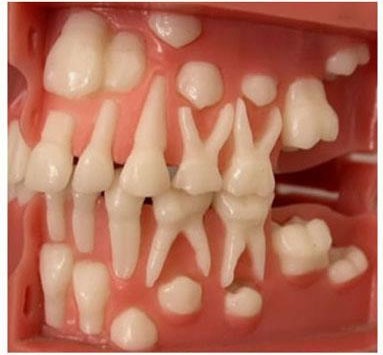
Regardless of how a primary tooth has gone missing, it is important for the pediatric dentist or orthodontist to evaluate for a space maintainer. Teeth that are left without one will start to drift and possibly block out the permanent tooth below the gum.
There are both removable and fixed space maintainers. Our doctors prefer the fixed ones, so that they know they are placed securely for as long as needed. The location of the missing tooth and how many teeth are missing are the deciding factor in what type of space maintainer is needed. The patient is fitted and the appliance is sent to a lab to be made custom.
Space maintainers are cemented into proper position and children adjust quickly within a few days. Extra oral hygiene care is needed around the bands and your dental provider will go over these instructions. Space maintainers are checked at regular 6 month dental cleanings or at regular evaluations from your orthodontist. The doctors will let you know when the proper time to remove the space maintainer will be.

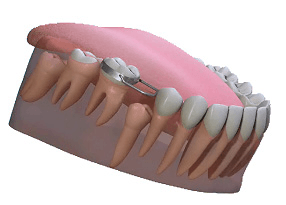
How teeth move with braces

Careful manipulation of force that is used to guide the teeth into a new and improved position is what allows orthodontics to move teeth. Together, the cells of the ligament, cementum and bone continually form and reform in response to the normal forces of the bite. Compression causes resorption (melting away or dissolving) of bone and cementum. Tension causes the cells to respond by depositing bone and cementum. Teeth have ligaments made from fibers. These fibers join to the root surfaces that are inserted into the cementum and on the other side of the ligament, the fibers insert into the bone. The total ligament is like a hammock that allows teeth to move in their sockets and to respond to stresses of biting forces.
Wires provide a force as it interacts with each specific bracket. Each of your teeth has a different size and shape, and so do the brackets. Each bracket is custom made for the particular tooth on which it’s supposed to fit. Brackets have small slots where we insert the wire and small elastic ties fit around the bracket to hold the wire in place.Pressure at the bracket produces pressure and tension at the root of the tooth, causing remodeling of bone and tooth movement. Elastics are worn at some point during orthodontic treatment, connecting from upper jaw to the lower jaw and creating force as well. Brackets, wires, and elastics work together to move teeth over time to achieve an optimal bite and beautiful smile.

